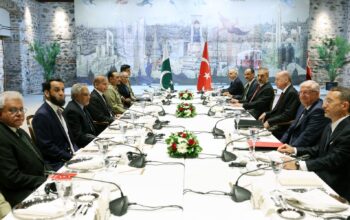Fitch downgrades Pakistan’s outlook from stable to negative, citing political risks ahead contributing to policy slippages.
By Staff Reporter
ISLAMABAD: While the economic repercussions of Pakistan’s developing political situation are yet to materialise, recent reports from two of the world’s top credit rating agencies show how the country’s internal politics figures in their calculus.
The Hong Kong based Fitch revised Pakistan’s outlook from stable to negative the other day, while affirming its long-term foreign-currency (LTFC) issuer default rating (IDR) at ‘B-’.
Both Moodys and Fitch see Pakistan’s staff-level agreement with the International Monetary Fund (IMF) over a multibillion-dollar bailout as a positive development; both see the deal winning the IMF Executive Board’s nod come August; but both take a dim view of Pakistan’s ability to complete the Extended Fund Facility (EFF) program and maintain a constructive policy path – chiefly on account of political risks.
“Renewed political volatility cannot be excluded and could undermine the authorities’ fiscal and external adjustment, as happened in early 2022 and 2018, particularly in the current environment of slowing growth and high inflation”, Fitch has said.
Noting that former Prime Minister Imran Khan, ousted in a no-confidence vote on April 10, has been agitating for early elections, and that regular elections are due in October 2023 any way, it sees the context creating “the risk of policy slippage”.
Moodys on its part says Pakistan’s ability to complete the current EFF programme and maintain a credible policy path that supports further financing remains highly uncertain, while elevated inflation and a higher cost of living are adding to social and political risks.
Fitch expects Pakistan’s current account deficit to be $17 billion in FY22, and sees current account deficit expanding on account of soaring oil prices and rise in other commodities’ import bill. It sees current account deficit narrowing in FY23 to $10 billion due to fiscal tightening, higher interest rates, and measures to limit energy consumption.
It sets Pakistan’s external debt maturities in FY23 at about $21 billion, about $9 billion of which are due chiefly to Saudi Arabia and China – including a $5 billion debt to Chinese commercial banks.
Fitch sees the probability of Pakistan’s fiscal deficit widening to 7,5% (or Rs 5 trillion) of GDP in FY22, as against around 6.1% in FY21 – but narrowing in FY23 to 5.6% of GDP (or Rs 4.6 trillion), higher than government estimates by about 1 percent.
Fitch forecasts inflation to be 19% in FY23, within the State Bank of Pakistan (SBP) forecast of 18-20%, and 8% in FY24. It sees debt to GDP ratio to decline to 66% in FY23, helped by high inflation and modest primary deficit.
After growing at a healthy 6 percent in FY22 largely due to loosening of fiscal policy led by higher private consumption, it expects the country’s economy to slow down to 3.5% in FY23 due to monetary tightening, high imported inflation, and weaker external demand outlook.
Moodys said last week Pakistan’s staff-level agreement with IMF was a credit positive and it would ease pressure on foreign exchange reserves.
IMF and Pakistan reached a staff-level agreement on policies to complete the combined seventh and eighth reviews of Pakistan’s EFF program. The agreement paves the way for the release of $1.2 billion in IMF financing at a time when the country’s foreign exchange reserves are under significant pressure.
Moodys notes that completing the reviews is also likely to unlock additional funding from other multilateral and bilateral partners.
In its August meeting, the IMF executive board will consider extending the programme until the end of June 2023 and increasing its size by $1 billion to $7 billion to support Pakistan’s programme implementation and meet its higher financing needs up to June 2023.
“The current account deficit has widened since mid-2021 on higher food and oil prices and stronger demand for imports”, notes Moodys. “[C]ombined with domestic political uncertainty, this has driven a sharp depreciation in the Pakistani rupee, further pushing up import costs.
“However, we expect the deficit to narrow to 3.5%-4% of GDP in fiscal 2023 from 4.5%-5% in fiscal 2022 as imports moderate amid slowing growth and measures to curb nonessential imports. Pakistan’s financing needs will remain high in fiscal 2023 amid continued high global commodity prices and the need to repay external debt.”
According to IMF data, Pakistan’s foreign exchange reserves declined to $8.9 billion in May, sufficient to cover less than two months of imports, although a slight increase is expected in June on the back of a $2.3 billion loan from Chinese state banks.
“We expect the IMF Executive Board to approve the $1.2 billion disbursement in the third quarter of this year”, it said. “We also expect Pakistan to maintain its engagement with the IMF, which would catalyse financing from other external sources as it focuses on policy priorities that the IMF has identified”.
The five policy priorities are implementing the fiscal 2023 budget, making progress on power sector reforms, lowering inflation, reducing poverty, enhancing governance, and mitigating corruption.
In this scenario, Moodys expects Pakistan to be able to meet its external financing needs for the next few years.
“Nonetheless, Pakistan’s ability to complete the current EFF programme and maintain a credible policy path that supports further financing remains highly uncertain, while elevated inflation and a higher cost of living are adding to social and political risks.
“The government may also find it difficult to continually enact revenue-raising reforms, such as steadily increasing petroleum levies and raising power tariffs, particularly in the run-up to the next general elections scheduled for mid-2023.”
Copyright © 2021 Independent Pakistan | All rights reserved



